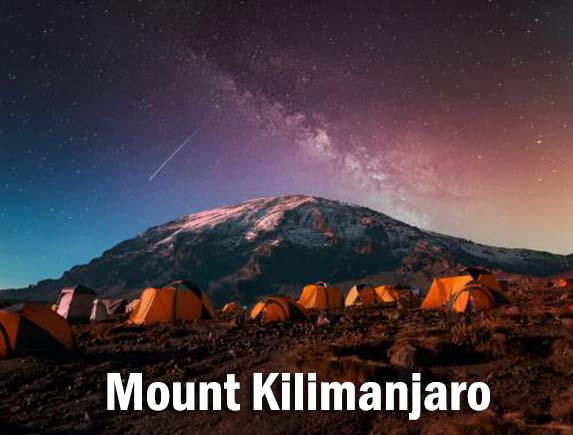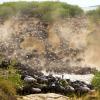Interesting Facts About Mount Kilimanjaro
Mount Kilimanjaro is a fascinating and iconic landmark located in Tanzania, East Africa.
Mount Kilimanjaro has three main peaks:
- Kibo: This is the highest peak and is where Uhuru Peak, the highest point on Kilimanjaro, is located. Uhuru Peak stands at approximately 5,895 meters (19,341 feet) above sea level.
- Mawenzi: This peak is the second-highest on Kilimanjaro but is technically more challenging to climb than Kibo. It stands at about 5,149 meters (16,893 feet) above sea level.
- Shira: Shira is a volcanic cone that is not as prominent as Kibo and Mawenzi. It is located on the western side of Kilimanjaro and is partially collapsed.
Kilimanjaro is known for its diverse climate zones, ranging from tropical rainforest to alpine desert. The mountain attracts climbers from around the world seeking to reach its summit, Uhuru Peak, which offers breathtaking views of the surrounding landscape.
Here are some interesting facts about this mt Kilimanjaro peaks:
-
Tallest Peak in Africa:
Mount Kilimanjaro is the tallest mountain in Africa, towering at approximately 5,895 meters (19,341 feet) above sea level. Mount Kilimanjaro is Africa's tallest mountain and one of the seven summits, which are the highest peaks on each continent. Here is the list of the seven summits in descending order of elevation:

- Asia: Everest (29,035 feet / 8,850 meters)
- South America: Aconcagua (22,834 feet / 6,960 meters)
- North America: Denali (20,310 feet / 6,190 meters)
- Africa: Kilimanjaro (19,341 feet / 5,895 meters)
- Europe: Elbrus (18,513 feet / 5,642 meters)
- Oceania: Carstensz Pyramid (16,023 feet / 4,884 meters)
Kilimanjaro is a popular destination for both experienced hikers and beginners because it is considered the easiest of the seven summits. Unlike the other peaks, climbing Kilimanjaro does not require technical skills or specialized equipment like ropes, harnesses, crampons, or ice axes. It is often referred to as a hiking or "walk-up" peak rather than a mountaineering or climbing peak. Many climbers who attempt Kilimanjaro have little to no hiking or backpacking experience beforehand.
-
Volcanic Origin:
Kilimanjaro is a dormant stratovolcano composed of three distinct volcanic cones: Kibo, Mawenzi, and Shira. Kibo is the highest peak and is capped by a glacier.
-
Unique Climate Zones:
Kilimanjaro is renowned for its diverse climatic zones, which range from tropical rainforest at the mountain's base to alpine desert and arctic conditions near the summit. Climbers experience drastic changes in temperature and vegetation as they ascend the mountain.
-
Glacial Retreat:
Kilimanjaro's glaciers have been receding rapidly over the past century due to climate change. Scientists predict that the glaciers may disappear entirely within the next few decades.
-
Cultural Significance:
Kilimanjaro holds cultural significance for the Chagga people of Tanzania, who have inhabited the mountain's foothills for centuries. It is also a popular destination for climbers from around the world.
-
Climbing Routes:
There are several established routes to the summit of Kilimanjaro, with varying degrees of difficulty and scenery. The most popular routes include the Marangu, Machame, Lemosho, and Rongai routes.
-
Uhuru Peak:
Uhuru Peak, located on Kibo's crater rim, is the highest point on Kilimanjaro and the ultimate goal for climbers. Watching the sunrise from Uhuru Peak is a breathtaking experience.
-
Biodiversity:
Despite its harsh conditions, Kilimanjaro supports a diverse array of plant and animal life, including endemic species found nowhere else on Earth.
-
Protected Area:
Mount Kilimanjaro is part of Kilimanjaro National Park, a UNESCO World Heritage Site designated for its natural and cultural significance.
-
Tourism and Conservation:
Tourism plays a significant role in the local economy, with thousands of climbers attempting to summit Kilimanjaro each year. Efforts to promote sustainable tourism and conservation are ongoing to protect the mountain's fragile ecosystem.
Mount Kilimanjaro's stunning beauty, rich biodiversity, and cultural significance make it a truly remarkable natural wonder and a bucket-list destination for adventurers and nature lovers alike.




